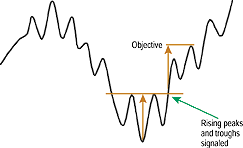Projecting Price
Do Price Patterns Really Work?
by Martin J. Pring
How far can you expect prices to go when they break out of a pattern? Here's one technique you can use to find out.
Technical analysis focuses on identifying trends early on and riding them until evidence of a reversal appears. Essentially, these trends are periods in which either buyers or sellers are in command, depending on the direction.
Fortunately for technicians, there is usually a transitional phase or trading range separating up- and downtrends. During these trading ranges, neither side is in control. Over the years, market participants have noticed that many of these ranges trace out fairly definable price formations, which, when completed with a breakout, signify that a new trend is under way (see Figure 1 for a bear/bull reversal).
Once prices break out from such a pattern, it is possible to set an objective by measuring the pattern's depth and projecting this distance in the direction of the breakout. In this article I will be concentrating on daily charts, but the principles apply to any time frame.
PATTERNS AND TECHNICAL CONCEPTS
We often think of price patterns as a single indicator, but in reality they encompass many basic technical principles. First is the concept of peak/trough analysis, which forms the basis of Dow theory. The idea behind this concept is that it is possible to recognize an incoming tide every time you spot a record wave, and vice versa. A rising trend in markets is also identified by each rally (wave) that surpasses its predecessor. By the same token, each low is set at a progressively higher level.

FIGURE 1: BEAR/BULL REVERSAL. When prices break out of a pattern, it is possible to determine how far they are likely to move.
...Continued in the April issue of Technical Analysis
of STOCKS & COMMODITIES
Excerpted from an article originally published in the April 2004 issue of Technical Analysis of STOCKS & COMMODITIES magazine. All rights reserved. © Copyright 2004, Technical Analysis, Inc.
Return to April 2004 Contents